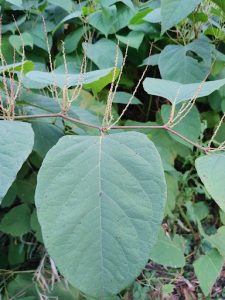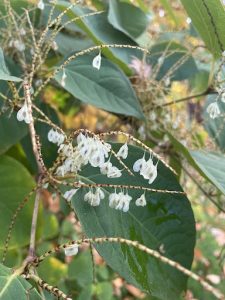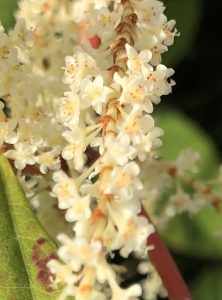Japanese Knotweed is a woody-stemmed herbaceous perennial 1-3 m tall, with annual stems extending from the perennial root system. It can grow up to 8 cm per day. New growth is purplish in color, and turns to green as the plant matures. Leaves are alternately arranged, 10–17 cm long and 7–10 cm wide, and oval to triangular in shape with a pointed tip and flat base. Flowers are small, white-green, borne in sprays near the ends of stems and in the leaf axils, and bloom from July– August. Seeds are small and winged for wind dispersal.
Japanese Knotweed grows primarily in urban habitats, but may also be found in riparian areas. It thrives in full sunlight, preferring open exposure, but can also survive in deep shade. Look for Japanese Knotweed along roadsides, ditches, fence lines, and around old homesteads. This invasive species grows in thick clumps that block out sunlight, effectively shading out native species and reducing biodiversity.
Japanese Knotweed was introduced to North America in the late 1800s as a horticultural plant, but has since escaped cultivation.
Giant Knotweed
Reynoutria sachalinensis
Woody-stemmed herbaceous perennial which can reach 2–4 m in height. Stems are smooth, hollow, and remain standing when dead. Leaves are heart-shaped, with thin hairs on their underside.

Bohemian Knotweed
Reynoutria ×bohemica
A hybrid of the Japanese and Giant Knotweed. Woody- stemmed herbaceous perennial up to 2–3 m in height. Leaves are spade- to heart-shaped, with short, broad hairs on underside of the leaf.

Oval to triangular leaves with flat base. Stems are hollow and smooth. Winged, triangular, small and shiny fruit.




The spring shoots of Japanese Knotweed are edible! Their flavour has been described as something like a cross between asparagus and rhubarb.
Promote the use of beautiful native plants for gardens and landscaping, and avoid planting invasive species. If removing Knotweed species from your property, be sure not to burn or compost the plant. Instead, double bag it and leave it in the sun to rot, then discard. Make sure to remove the entire root system, or else the plant will resprout from the rhizome fragments. Digging up young Knotweeds is the best way to prevent new or early infestations. Alternatively, you can cover the plant with dark material to block out the sun and “cook” the plant. This process, called tarping, is best done when started in late spring. It is not recommended for low light areas. If you spot this invasive species, report the location to iNaturalist, or directly to the NSISC.
Join our mailing list.